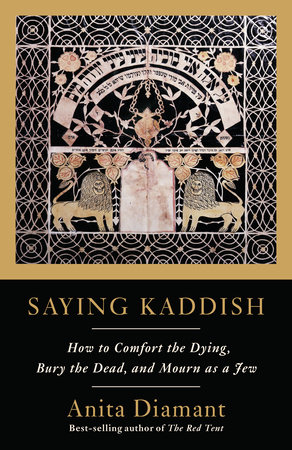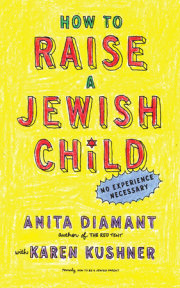PREFACE (to revised edition) I began writing this book during the second year following my father’s death in 1995, with the memory of his loss and the experience of sitting
shiva and saying Kaddish still present in my mind and heart.
Maurice Diamant was seventy-two when he died. It was a “good death,” free of suffering or fear. He had made his wishes known and said his goodbyes to friends and family—including me. Yet even though I knew it was coming, the shock of his death was staggering. The world I had known was gone. I would never be the same. A friend who lived above the San Andreas Fault described the feeling as “a private earthquake.”
During the days and weeks after my father died, I explored the quiet devastation of his loss. I assumed the role of mourner, but as lonely as the world was without my father, I was not alone. My family and my community comforted me, and I found myself traveling down a path made smooth by centuries of Jewish mourners.
I decided to stay home for the first week to sit
shiva, which allowed—actually, forced—me to experience the overwhelming first stage of grief and the meaning of the word “consolation.” Friends, neighbors, and members of my synagogue came to the door, carrying food. I was hugged and kissed and cared for in the most elemental ways. My rabbi sat with me at the kitchen table one quiet afternoon. I reminisced about my father; my rabbi described the trajectory of mourning.
I remember very little of what people said to me during
shiva. But the sounds of their voices, their presence in my home, and the cards and notes that arrived in the mail were meaningful beyond measure. Grief weighed heavily, but others held me up.
Members of my congregation led a brief prayer service in the evening. Before we recited the final prayer, the Mourner’s Kaddish, my husband and I shared memories of my father. My then-nine-year-old daughter read a poem she had written about him. Friends recalled conversations they’d had with him and, after a few minutes, people who had never met my dad knew that he loved a joke and passionate conversation; that he was an eternal optimist; and that despite his own life experience, he never lost his faith in humanity.
Then we said Kaddish:
Yit-ga-dal ve’yit-ka-dash sh’mei ra-ba. I knew the words by heart from synagogue services, but what had been familiar—even rote—now became a mantra of sadness and longing, a personal petition for peace, an extended “amen” to another exhausting day.
In addition to notes and cards, the mail brought news of donations to causes that reflected my father’s values. There were contributions to the library at his temple and to the memorial garden at mine; there were gifts to Amnesty International and organizations that support non-Jews who rescued Jews during the Holocaust. I continue to give charity—
tzedakah—in his memory. I always will.
My father’s death taught me the meaning of the word “blessing.” His memory—even decades later—is a reminder to be kind, to laugh, to appreciate nature and music and friendship.
My mother, Helene Diamant, died twenty-two years after my father. She was ninety-two but in good health, and her death was sudden and unexpected. I was grateful that she died without suffering or the loss of her independence—an idea she found intolerable.
This time I was more familiar with the path ahead of me, and the shock was mitigated by the span of her years. Even so, I was no less touched by and grateful for the loving support of friends and acquaintances from every corner of my life and hers. Generous gifts were given in her memory, and the cards and letters were full of tenderness and affection. Again, I was surrounded by love and deeply grateful for the community that supported me during
shiva and held me close during the disorientation I felt in the months that followed. As I took up the familiar consolations of Kaddish, candles, and
tzedakah in her memory, I took pleasure in finding homes for her impressive collection of owls and knowing that her winter coats and boots were keeping homeless women warm through the winter.
As the first year of mourning came to a close, I resumed my lifelong study of French, which I realized later was probably an unconscious tribute to my mother’s first language and a way to maintain a fond connection with her.
Why update
Saying Kaddish? Certainly, there is more continuity than change in Jewish practices related to death and mourning. The enduring wisdom of our tradition helps us face death squarely and make time to feel the full range of emotions—grief, anger, fear, guilt, relief—that follow; accept the fact that we need other people to help bear the pain of loss; do the same for others when they lose a loved one; and take comfort from the idea that the memory of the dead is bound up in our lives and actions.
There were some obvious reasons for a revision: organizations have changed their names and new resources are available. The Internet and social media have become sources of connection and solace.
But there have been more profound changes as well. North American Jews have embraced ancient rituals and customs that were forgotten or seemed off limits to many, including
taharah—preparation of the body for burial by a
hevra kadisha (burial society)—and the use of ritual immersion in a
mikveh to mark stages of bereavement.
The Jewish community is also part of a larger cultural shift that encourages frank and open conversation about the difficult choices at the end of life and the benefits of creating medical directives and naming healthcare proxies. Hospice, palliative services, and spiritual care have provided relief and comfort for terminally ill patients and support for loved ones and caregivers.
We are also far more inclusive than we were twenty years ago. Jews by choice, Jews of color, non-Jewish family members, and LGBTQ Jews are welcome and cherished in most (though not yet all) communal settings.
The rituals, prayers, and customs in this book are meant for everyone who needs them. The idea that all human beings are created
b’tzelem Elohim, in the image of God, is a foundational Jewish belief that finds expression in the ways Jews care for the human body after death. The same plain white garments and the same simple wooden coffins are provided for all, regardless of gender or status: rich or poor, wise or foolish, having left a legacy of good deeds or a trail of tears.
——————
It’s hard to think about death, which is why most people die without writing a will. Nobody is eager to read something entitled
Saying Kaddish. It’s a book of last resort. Philosophers and theologians have long recommended the contemplation of death as a way to stay in touch with the beauty of life, but it’s a very hard subject to dwell on.
Still, grief is an inescapable fact of humanness—like the opposable thumb, or laughter. We have no choice: if we live long enough, we are bound to lose people we love. But we do have choices in how we prepare for death and how we grieve. I hope that this book will help you find meaningful choices as you negotiate the valley of the shadow of death, whether you are caring for someone who is grievously ill, visiting someone who is sitting
shiva, or are yourself struck low by loss. If you are in mourning (which is not merely a figure of speech but a real place, out of time), I hope you have good memories of the one who died. For those whose grief is complicated by anger, disappointment, distance, pain, or terrible circumstance, I hope that you can find meaning or solace in Jewish ritual and practice. I pray that you have a community to hold you close.
I’m always touched and grateful when I meet readers who tell me how much they enjoyed
The Red Tent and my other novels, or who thank me for the help they found in my books about Jewish weddings, conversion, and other milestones. But when someone mentions
Saying Kaddish, I feel a special connection. Our eyes meet. They say, “My mother . . .” or “My partner . . .” Or, worse, “My daughter . . .” or “My son . . .” I think of my own losses, and we recognize one another as fellow mourners.
You and I will meet in the pages of this book. Perhaps you are opening it while sitting
shiva, in a moment when the house is empty of guests. Or maybe it’s a few months after the funeral, when the phone calls have slowed and the refrigerator has emptied out. As you turn the pages, remember that you are part of a timeless line of mourners who have walked this path before you. You are not alone.
. All rights reserved. No part of this excerpt may be reproduced or reprinted without permission in writing from the publisher.










